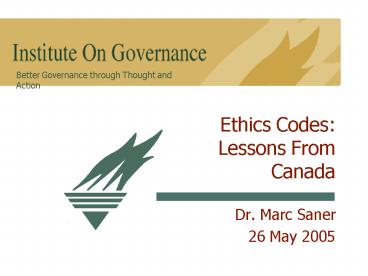Ethics Codes: Lessons From Canada - PowerPoint PPT Presentation
1 / 30
Title:
Ethics Codes: Lessons From Canada
Description:
Report by the Task Force on Public Service Values and ... Law. Unwritten codes. Culture. Pledges. Spirituality. Mentoring. Dialogue. Institute On Governance ... – PowerPoint PPT presentation
Number of Views:214
Avg rating:3.0/5.0
Title: Ethics Codes: Lessons From Canada
1
Ethics Codes Lessons From Canada
- Dr. Marc Saner
- 26 May 2005
2
Table of Contents - Part 1
- Canadas Approach
- A very abbreviated history
- Analysis Five principles
- Are these principles universal?
3
Table of Contents - Part 2
- Two Challenges (for Everyone)
- Compliance vs. integrity
- Designing a process
- Country-specific solutions
4
Canadian Ethics Codes History
- Report by the Task Force on Public Service Values
and Ethics (1996) - Auditor General Report (2000)
- Code for Members of the House of Commons (2004)
- Code for Public Office Holders (2003-2004)
- Available in Spanish
- Code for Public Servants (2003)
5
Analysis Five Guiding Principles
6
Principle 1
7
The Principle is a True-ism for Rulers
- Importance of ethical leadership has long been
understood Sample quotes - Aristotle The ruler ought to have moral virtue
in perfection. - Confucius The institutions of the ruler are
rooted in his own character and conduct. - Is ethical leadership only for rulers?
8
Power is Tied to Accountability
Also Lobbyists, Judges, Media,
Multiple levels of power -gt Need for a diverse
system
9
Principle 2
10
The Canadian System of Codes (Simplified)
11
Codes Are Only One Tool
- Examples of other instruments
- Law
- Unwritten codes
- Culture
- Pledges
- Spirituality
- Mentoring
- Dialogue
12
Principle 3
13
From Recruitment to Performance Evaluation
Canadas Management Accountability Framework
Public Service Values
Results Perform-ance
Governance Strategic Direction
Policy and Programs
Citizen Focused Service
People
Stewardship
Accountability
Risk Management
Learning, Innovation and Change Management
14
Principle 4
15
Revisions and Audits are Planned
- Explicit statement of periodic review is included
in the codes - Canadian Auditor General reviews values and
ethics every 3-5 years - (e.g., Chapter 12, 2000)
16
Principle 5
17
Public Disclosure and Annual Reports
- Disclosure of conflicts-of-interest
- Public declaration
- Annual report
18
Are the Principles Universal?
- I leave the judgment to you
- They have been used here as a way to classify
elements of the Canadian approach - What really counts, however, is the adaptation to
country-specific needs
19
Part 2
- Two Challenges (for Everyone)
- Compliance vs. integrity
- Designing a process
- Country-specific solutions
20
Practice Two Challenges
- Balancing compliance and integrity
- First an ideological, then a practical challenge
- The art of designing the process
- Incremental and forceful, inclusive and coherent,
flexible and consistent,
21
An Ideological Challenge
- Common ideology Big problems require big
measures - Strong, mandatory standards
- Strong enforcement COMPLIANCE
- Strong punishments
- Increasing evidence that this view is too
simplistic - Voluntary approaches
- Smart regulations INTEGRITY
- Integrity, culture and spirituality
- Conclusion
- Keep an open mind OUTCOME-ORIENTATION
22
Types of Codes
- Compliance codes
- A list of rules and limits that need to be
respected by all users - Values-based (integrity) codes
- A list of commonly shared values and guiding
principles
23
Nature of Codes
- VALUES-BASED
- Flexibility
- Works with unexpected
- Dialogue approach
- Fosters team work
- Brief
- Own judgment
- Owned by all
- COMPLIANCE-BASED
- Consistency
- Predictable decisions
- Analytic approach
- Fosters precision
- Detailed
- Enforceable
- Implementation can be top-down
24
Benefits of Codes
- COMPLIANCE-BASED
- Workplace
- Good outcomes through enforcement
- Environment
- Good outcomes because standards match environm.
requirements audit and enforcement work well
- VALUES-BASED
- Workplace
- Good outcomes from the good judgement of
participants - Environment
- Good outcomes from experienced, empowered,
thinking, cooperative staff
25
Developing Codes
- Top-down
- Legality, analysis
- Match to organizational commitments
- Keep an eye on performance measurement
- Works best with compliance-based codes
- Bottom-up
- Buy-in
- Distill existing culture
- Learn from the staff level
- Required for values-based codes
26
Outcome-oriented Codes
- Outcome-oriented codes are the best possible
combination - of elements from values and compliance codes
- for a given situation
- judged by the outcome one wants to achieve
- Need for two-pronged approach
- Compliance analysis and legal integration
- Values dialogue and workplace integration
27
Additional Ideas for Process
- The public service is a public trust
- Cannot systematically exclude the public
- Adaptive planning
- Do something practical that needs to be done and
can be done - For example Transparency of legal process gtgtgt
Legal aid for the poor
28
Summary and Conclusion
- Diversity of the Canadian experience provides a
menu and broad strategy - Codes matched to level of power and
responsibility - A diverse system that is being adapted over time
- Intention of full integration and transparency
- In practice, consider this development procedure
- (1) Identify a starting point, an achievable goal
- (2) Consider a very broad team, including the
public - (3) Force the compliance vs. integrity
discussion - (4) Design the process towards outcome-orientatio
n - (5) Practice adaptive planning
29
Further Information
- www.iog.ca
30
Score Card for Canada
- 1. Leadership
- Sponsorship Scandal
- 2. Diversity
- Well established
- 3. Integration
- Launch of public service ethics code rushed
- Focus still very strong on conflicts-of-interest
- 4. Adaptation
- Appears to work
- 5. Transparency
- Access to Information -gt culture change































